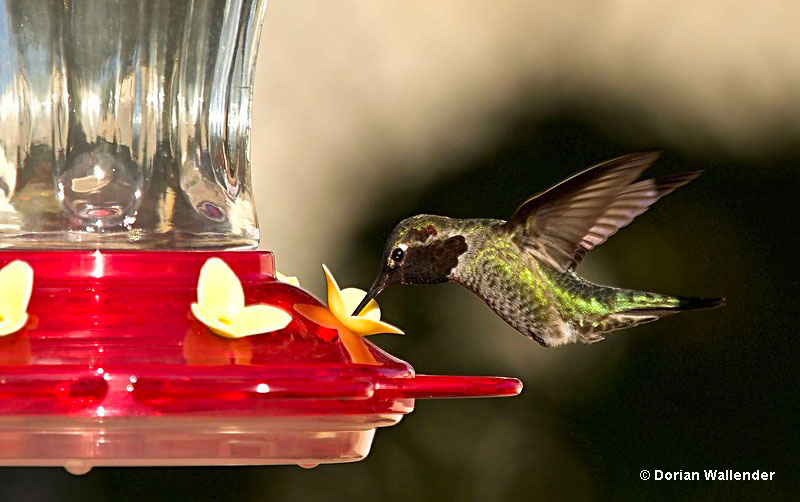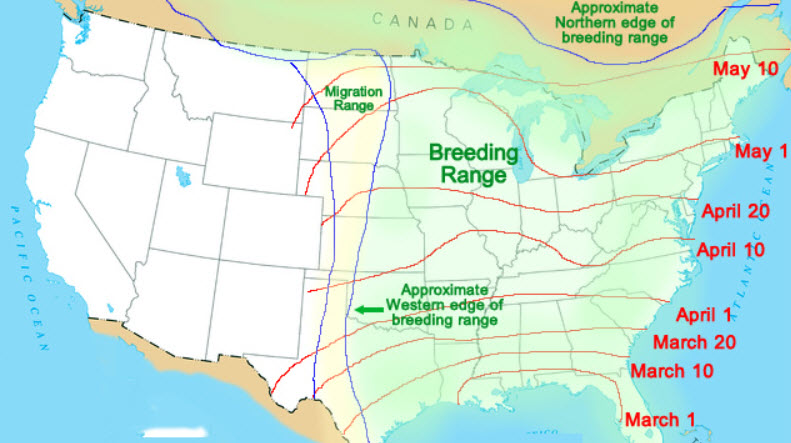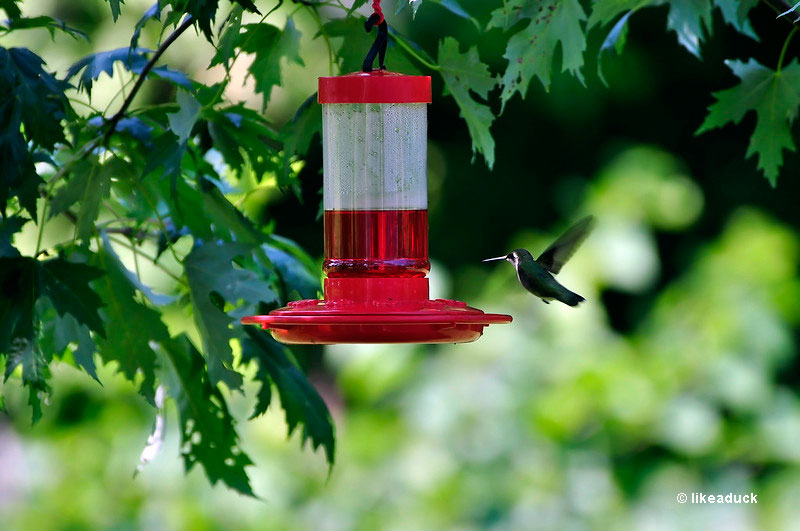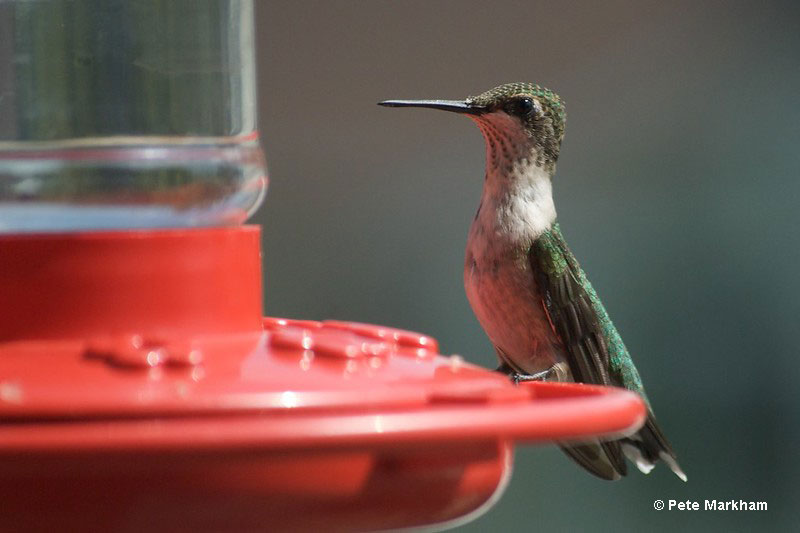
Spring is around the corner, and hummingbirds are starting to arrive. In no time, these little creatures make their way to our backyards, looking for sustenance, so why not offer them some?
Chances are, now that hummingbirds are starting to arrive from their wintering grounds, more and more little hummers are finding their way to your feeder.
But one question remains: when is the right time to put up hummingbird feeders?
On this page
When To Put Out Hummingbird Feeders?
Hummingbirds aren’t always present.
In most places, they migrate to warmer regions for the winter. With that in mind, we only need to put out hummingbird feeders when the little birds are migrating through or in the area for breeding.
However, in some places, hummingbirds visit feeders all year long. Those regions include coastal California, southeastern British Columbia, Florida, the Gulf Coast, southern Arizona, southern New Mexico, and much of southern and eastern Texas.
Hummingbird feeders from the coastal North Carolina area to Georgia can also attract hummingbirds all year long.
In other parts of North America, putting out hummingbird feeders should be timed with hummingbird migration. In general, migrant hummingbird arrival coincides with budding and flowering trees.
In most places, mid-March is a good time to put out the hummingbird feeder, although, in much of Canada, mid-April works better.
We can keep the feeders out for the rest of spring and summer and take them down again in September.
By States
- Alabama: Late March
- Alaska: Late April / Early May
- Arizona: Varies by region, generally March to April
- Arkansas: Mid-April
- California: Varies by region, generally March to April
- Colorado: Late April / Early May
- Connecticut: Late May
- Delaware: Mid-May
- Florida: Late February / Early March
- Georgia: Late March
- Hawaii: No hummingbirds
- Idaho: Late April / Early May
- Illinois: Late May
- Indiana: Late May
- Iowa: Late May
- Kansas: Late April
- Kentucky: Early May
- Louisiana: Mid-March
- Maine: Late May
- Maryland: Mid-May
- Massachusetts: Late May
- Michigan: Mid to Late May
- Minnesota: Late April to Mid-May
- Mississippi: Mid-March
- Missouri: Late April
- Montana: Mid-May
- Nebraska: Early May
- Nevada: Varies by region, generally March to April
- New Hampshire: Late May
- New Jersey: Late May
- New Mexico: Varies by region, generally March to April
- New York: Late May
- North Carolina: Mid-April
- North Dakota: Late April to Mid-May
- Ohio: Late May
- Oklahoma: Mid-April
- Oregon: Varies by region, generally March to April
- Pennsylvania: Late May
- Rhode Island: Late May
- South Carolina: Mid-April
- South Dakota: Late April to Mid-May
- Tennessee: Mid-April
- Texas: Early March
- Utah: Late April / Early May
- Vermont: Late May
- Virginia: Early May
- Washington: Varies by region, generally March to April
- West Virginia: Early May
- Wisconsin: Late April to Mid-May
- Wyoming: Late April / Early May

Map Source: HummingbirdPlus.org
Or By Months:
Late February / Early March: Florida & Texas
Mid-March: Louisiana, Mississippi
Late March: Alabama, Georgia
Early April: South Carolina, North Carolina
Mid-April: Tennessee, Arkansas, Oklahoma
Late April: Missouri, Kansas, Kentucky
Early May: Virginia, West Virginia, Texas (Central parts), Louisiana (Central parts), Mississippi (Central parts)
Mid-May: Delaware, Maryland, New Jersey, Tennessee (Central parts), Georgia (Central parts), Alabama (Central parts), Missouri (Central parts), Arkansas (Central parts), Illinois (Southern parts), Indiana (Southern parts), Ohio, Oklahoma (Central parts), North Carolina (Northern parts), South Carolina (Northern parts)
Late May: Vermont, New Hampshire, Massachusetts, Rhode Island, Connecticut, New York, Pennsylvania, Wisconsin, Michigan, Iowa, Minnesota, North Dakota, South Dakota, Nebraska, Wyoming, Montana, Colorado, New Mexico, Utah, Idaho, Oregon, Washington, Nevada, California, Alaska (Late April / Early May for some parts)
Please note that these dates are approximate, and hummingbird migration can be influenced by various factors each year. The timing of their arrival can also vary within a state, depending on its size and geographical features.
Where Should You Place the Hummingbird Feeder?
Where we put up a hummingbird feeder is just as important as when we put up the feeder. First and foremost, since hummingbird feeders require cleaning and refilling, they should be placed within easy reach.
We also want to install hummingbird feeders where they can be easily watched from the house. After all, watching those little beauties while enjoying a coffee, drink, or other treat is one of the mean reasons for putting up the hummingbird feeder in the first place.
Related: How fast do hummingbirds fly?
However, we don’t want to put the feeder in direct sunlight. The constant sun helps ferment the sugar water and boost mold growth. To prevent mold, it’s best to put up the feeder in a shaded, or semi-shaded spot.
To help hummingbirds feel safe, we should also place the feeder away from other feeders and 10 to 15 feet from trees and shrubbery. Those shrubs and trees also give our little friends a nice place to rest between bouts of feeding.
Importance of Choosing the Right Feeder
There are a bunch of different hummingbird feeders available. Which hummingbird feeder is best? Although we all have personal preferences about the appearance of hummingbird feeders, there are a few important things to keep in mind.
Related: How to make your own hummingbird food?
Two of the most important factors are size and simplicity. These factors are related to the most important thing to consider; how often and easy it is to clean the feeder.
Think about the types and numbers of hummingbirds that visit the backyard. If we have a lot of hummingbirds, we may want a larger feeder. However, if the hummingbirds haven’t made a dent in the amount of sugar water in the feeder over five days, the feeder is too big.
The feeder is about the right size if they drink all of the sugar water in four to six days.
With that in mind, we must also consider how easy it is to clean and maintain the feeder. Every hummingbird feeder should be cleaned at least once per week. To facilitate cleaning a feeder, we should make sure that it is easy to take apart and very easy to clean thoroughly.
For example, a decorative hummingbird feeder might look fantastic, but if you can’t clean it well, you can’t really use it.
Frequently Asked Questions
Where is the best place to hang a hummingbird feeder?
The best place to hang a hummingbird feeder is in a semi-shaded spot 10 to 15 feet from shrubs and trees. For cleaning purposes, it should be easy to reach, and also be visible from a good viewing spot.
What time of day is best to feed hummingbirds?
The best time of day to feed hummingbirds is right at dawn and in the late afternoon. These are the times when hummingbirds feed the most, although they will also feed throughout the day.
Should hummingbird feeders be in the sun?
No, hummingbird feeders should be kept in semi-shaded areas. If hummingbird feeders are placed in direct sunlight, mold and bacteria can grow, and the sugar water can become fermented.
What do you put in a hummingbird feeder?
You put sugar water in a hummingbird feeder. The proportions are one-fourth of a cup of sugar for each cup of water.
What season are hummingbirds most active?
Hummingbirds are most active during spring and summer. However, hummingbirds can be active all year long in coastal California, the southwestern USA, Texas, along the Gulf of Mexico, and Florida.



